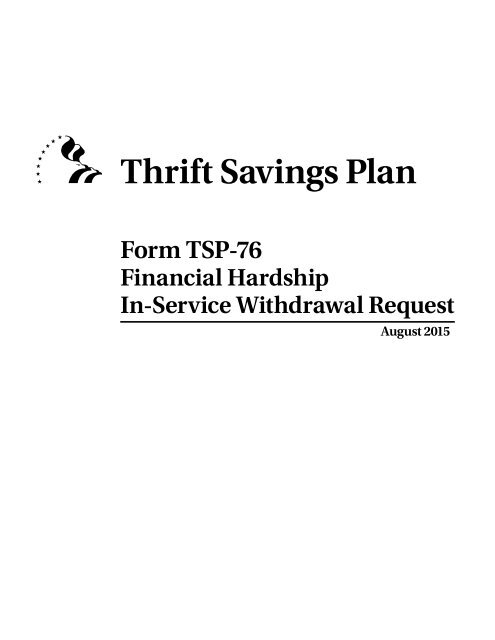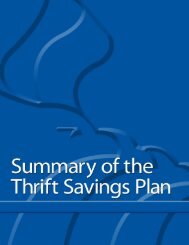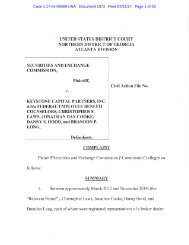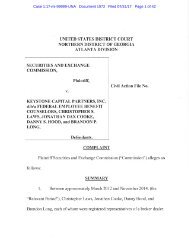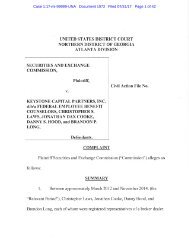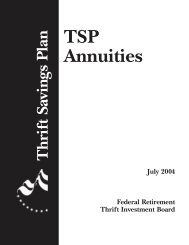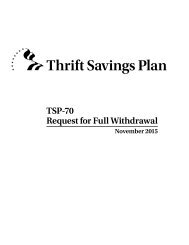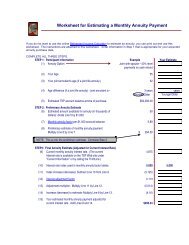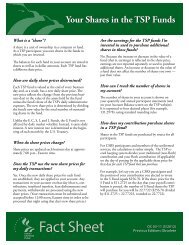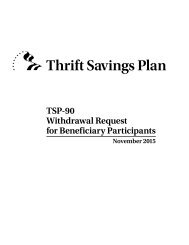tsp-76
Create successful ePaper yourself
Turn your PDF publications into a flip-book with our unique Google optimized e-Paper software.
Thrift Savings Plan<br />
Form TSP-<strong>76</strong><br />
Financial Hardship<br />
In-Service Withdrawal Request<br />
August 2015
GENERAL INFORMATION<br />
If you are a Thrift Savings Plan (TSP) participant and you are employed by the Federal Government as a Federal civilian employee<br />
or as a member of the uniformed services, you may be able to request a financial hardship in-service withdrawal.<br />
To qualify, you must have an immediate and significant financial need that necessitates a distribution from your TSP account<br />
and your need must arise out of either a recurring negative monthly cash flow situation, medical expenses, legal expenses<br />
for separation or divorce, or personal casualty loss. You cannot request a financial hardship withdrawal for expenses that you<br />
have already paid or that are reimbursable to you. In addition, the following conditions apply:<br />
• Your TSP account must contain at least $1,000 of your own contributions and earnings on those contributions.<br />
• You have not received a financial hardship in-service withdrawal from the same account within the previous 6 months.<br />
• You do not have an application pending for an age-based in-service withdrawal or for a TSP loan.<br />
Before requesting a withdrawal, you should read the TSP booklet In-Service Withdrawals and the TSP tax notice “Important Tax<br />
Information About Payments From Your TSP Account.” If you do not have these materials, you can obtain them from the TSP<br />
website (<strong>tsp</strong>.gov) or from your agency or service. These materials provide detailed information about the effect of a financial<br />
hardship withdrawal on your retirement savings and the tax consequences of your withdrawal. For example, when you<br />
make a financial hardship withdrawal:<br />
• The TSP will automatically stop your TSP contributions for 6 months. If you are a FERS employee, this means that you<br />
will not receive Agency Matching Contributions during that time. If you are a member of the uniformed services, this<br />
means that your contributions from incentive and special pay, including bonuses, will also stop.<br />
• You permanently deplete your retirement savings by the amount of your withdrawal plus any future earnings you<br />
could have received on that amount.<br />
• The taxable portion of your withdrawal is subject to Federal income tax (and may be subject to state and local tax,<br />
depending on your residence). An additional 10% early withdrawal penalty tax applies if you are younger than age 59½<br />
when you make the withdrawal, unless you satisfy one of the Internal Revenue Service’s exceptions to this penalty.<br />
Note: Withdrawals of tax-exempt contributions in a traditional balance and any Roth contributions are not subject<br />
to Federal income tax. However, if you have not met the conditions necessary for your Roth earnings to be qualified<br />
(i.e., paid tax-free), any Roth earnings included in the withdrawal will be subject to Federal income tax. Roth earnings<br />
become qualified when you have reached age 59½ (or are permanently disabled*) and five years have passed since<br />
January 1 of the year of your first Roth contribution.<br />
If you are in pay status and eligible for a loan, you might consider taking a loan rather than making a withdrawal.<br />
SPOUSES’ RIGHTS: If you are married (even if separated from your spouse), spouses’ rights apply to the financial hardship<br />
in-service withdrawal from your account as follows:<br />
Spouses’ Rights for In-Service Withdrawals<br />
Classification Requirement Exceptions<br />
FERS and Uniformed<br />
Services<br />
Spouse must provide consent to the<br />
in-service withdrawal. Your spouse’s<br />
signature must be notarized.<br />
Exception may be requested<br />
if whereabouts are unknown<br />
or exceptional<br />
circumstances exist.<br />
CSRS<br />
The TSP must notify your spouse of the<br />
request for an in-service withdrawal.<br />
Exception may be requested<br />
if whereabouts are unknown.<br />
If you cannot obtain your spouse’s signature (FERS and uniformed services) or you do not know your spouse’s whereabouts<br />
(CSRS), provide your spouse’s Social Security number on the form and submit Form TSP-16, Exception to Spousal Requirements<br />
(or TSP-U-16 for uniformed services), along with the required documentation.<br />
* The TSP cannot certify to the IRS that you meet the Internal Revenue Code’s definition of disability when your taxes are reported. Therefore,<br />
you must provide the justification to the IRS when you file your taxes.
Worksheet to Determine Financial Hardship<br />
Use the instructions below to help you complete the worksheet. If you are married, please include financial information for your<br />
spouse.<br />
SECTION I. Calculation for Negative Cash Flow<br />
A. To determine your allowance for ordinary monthly household<br />
expenses, first determine your gross monthly income as<br />
explained in the instructions below and enter that amount on<br />
the line provided. Then, locate your income in the chart on the<br />
right and move across to choose the factor that correlates to<br />
your family size. Enter that factor on the line provided and<br />
multiply it by the amount of your gross monthly income.<br />
Enter the result (rounded to the nearest whole dollar)<br />
on Line A.<br />
Factor for Family Size of:<br />
Gross Monthly Income 1 or 2 3 or 4 5 or more<br />
Less than $1,250 .85 .90 .90<br />
$1,250 – 1,666 .70 .80 .80<br />
$1,667 – 2,499 .60 .65 .70<br />
$2,500 – 3,332 .50 .55 .60<br />
$3,333 – 4,166 .40 .50 .50<br />
$4,167 – 5,832 .40 .45 .50<br />
$5,833 or more .30 .35 .40<br />
x =<br />
Gross Monthly Income Factor<br />
A<br />
B. Enter your monthly scheduled household expenses (see instructions below):<br />
C. Enter your total monthly household expenses by adding Lines A and B:<br />
D. Enter the total net monthly income (see instructions below):<br />
E. Subtract Line D from Line C to determine whether you have a negative cash flow. If Line C is<br />
the same as or less than Line D, you do not have a negative cash flow and should not complete Item F.<br />
F. Multiply Line E by 6 months.<br />
This is the amount you can request due to negative cash flow:<br />
SECTION II. Extraordinary Expenses<br />
G. Total amount of allowed unpaid and unreimbursable medical expenses:<br />
(This is the amount you can request for medical expense reasons.)<br />
H. Total amount due to unpaid and unreimbursable personal casualty loss:<br />
(This is the amount you can request due to personal casualty loss.)<br />
I. Total amount of unpaid and unreimbursable legal expenses for separation or divorce:<br />
(This is the amount you can request to cover your legal expenses due to separation or divorce.)<br />
SECTION III. Maximum Request Amount<br />
J. Add Items F, G, H, and I. (This is the maximum financial hardship withdrawal you can request.)<br />
INFORMATION AND INSTRUCTIONS FOR THE WORKSHEET:<br />
E<br />
x 6 =<br />
B<br />
C<br />
D<br />
E<br />
F<br />
G<br />
H<br />
I<br />
J<br />
To determine negative cash flow, complete Section I above. If you are requesting a financial hardship for another reason, complete<br />
Section II. Complete both sections if you have a negative cash flow and extraordinary expenses.<br />
• The allowance for ordinary household expenses (Item A) takes into account ordinary monthly recurring expenses (e.g., food, clothing,<br />
household operations, education, health insurance premiums), including expenses frequently charged to credit cards.<br />
If you are in pay status, determine gross monthly income by adding your gross monthly pay and any other monthly income (such as<br />
child support) for you and, if applicable, your spouse. Your gross pay is your pay before taxes and any other deductions are taken out.<br />
If you are in nonpay status, determine your gross monthly income by using your annual salary shown on your earnings and leave<br />
statement. Divide this amount by 12 and then add any other monthly income for you and, if applicable, your spouse.<br />
If any income for you or your spouse is not monthly, you will need to calculate the monthly amount. For example, if you are paid 26<br />
times a year (biweekly), multiply the biweekly amount by 26 and divide by 12.<br />
• Your monthly scheduled household expenses (Item B) include your rent or mortgage, real estate tax, your homeowner’s or renter’s<br />
insurance, and monthly household utilities (if these items are paid separately from your mortgage or rent), dependent care (including<br />
necessary household help due to illness or injury) and any expenses you pay for alimony, maintenance, or child support. You<br />
should also include any installment loan payments other than those related to a TSP loan. Do not include credit cards or charge accounts<br />
or any interest charges on them. These items are considered in your allowance for ordinary monthly household expenses.<br />
• To calculate the net monthly income (Item D) for you and your spouse, add the monthly amounts for Federal, state, and local income<br />
tax withholding, OASDI (Social Security)/Medicare, and monthly Federal retirement deduction (i.e., FERS, CSRS, or uniformed<br />
services). If your spouse has any other type of monthly retirement plan deductions or makes monthly TSP contributions, also add in<br />
those items. Subtract this total from the gross monthly income you provided on Line A and enter the result on Line D.<br />
This worksheet is for your records only. Do not submit it with your form.
!<br />
You are about to request a financial hardship withdrawal. You should be aware of the following:<br />
You will be unable to make any TSP contributions for 6 months.<br />
This means that you cannot make traditional, Roth, or catch-up<br />
contributions, or contribute from incentive, special, or bonus<br />
pay during that time.<br />
If you are eligible for matching contributions from your agency<br />
or service, you will not receive them during the 6-month<br />
period that you cannot contribute.<br />
The amount you withdraw combined with 6 months of missed<br />
contributions and matching can reduce your retirement savings<br />
by thousands of dollars over time.<br />
You may have to pay taxes and a 10% early withdrawal penalty<br />
on the money you withdraw.<br />
Be aware that if you have a significant financial hardship<br />
and are in pay status and eligible for a TSP loan, you can<br />
request a loan rather than a withdrawal. If you take a<br />
loan from your TSP account:<br />
• You can pay yourself back with interest; your loan payments<br />
go directly into your TSP account.<br />
• You can continue your contributions, and your matching<br />
contributions will not be affected.<br />
• However, your long-term retirement savings will be<br />
negatively impacted because you will not accrue earnings<br />
on your loan amount.<br />
• You must pay a $50 loan fee.<br />
• You will not pay taxes on your loan amount.*<br />
For more information about each option, visit the Plan Participation section of <strong>tsp</strong>.gov.<br />
* Unless your loan is not paid back and the TSP declares a taxable distribution. When the TSP declares a taxable distribution, the Internal<br />
Revenue Service (IRS) considers the unpaid balance (including any accrued interest) of the loan to be taxable income.<br />
INSTRUCTIONS FOR PAGE 1<br />
To ensure that your request is not delayed, carefully type or<br />
print the requested information using black or dark blue ink.<br />
If printing, please use simple block letters and numbers.<br />
Keep all letters and numbers inside the boxes.<br />
Be certain to provide all the information requested on the<br />
form. If you do not, your form may be rejected.<br />
SECTION I. Check whether you are withdrawing money from<br />
your civilian or uniformed services account in Item 1. Check<br />
only one box. You cannot withdraw from both accounts<br />
using one form. If you have two TSP accounts, and you<br />
do not check a box, your form will not be processed.<br />
SECTION II. If you are a FERS or uniformed services participant,<br />
your spouse must consent to your financial hardship<br />
withdrawal by providing his or her name and signature in Item<br />
6, and by dating the form in Item 7. The signature must be<br />
notarized. Because the form will be filed with a Federal agency<br />
in Washington, D.C., the notary must complete the information<br />
in Item 8. No other acknowledgement is acceptable. If you<br />
cannot obtain your spouse’s signature, provide your spouse’s<br />
name in Item 6 and Social Security number in Item 9, and<br />
submit Form TSP-16, Exception to Spousal Requirements (or<br />
TSP-U-16 for uniformed services).<br />
SECTION III. If you are a CSRS participant, the TSP must<br />
notify your spouse of your hardship withdrawal. Provide your<br />
spouse‘s name in Item 10. If your spouse’s address is the<br />
same as your address in your TSP record, check “Yes” in Item<br />
11 and go to Section IV on Page 2. If your spouse’s address is<br />
PRIVACY ACT NOTICE. We are authorized to request the information you<br />
pro vide on this form under 5 U.S.C. chapter 84, Federal Employees Retirement<br />
System. We will use this information to identify your TSP account and to process<br />
your request. In addition, this information may be shared with other Federal agencies<br />
for statistical, auditing, or archiving purposes. We may share the information<br />
with law enforcement agencies investigating a violation of civil or criminal law, or<br />
not the same as yours, check “No” in the second box and<br />
complete Items 12-16. If you do not know your spouse’s<br />
address, check the third box in Item 11, provide your<br />
spouse’s Social Security number, and submit Form TSP-<br />
16, Exception to Spousal Requirements.<br />
If your spouse has a foreign address, check the box in<br />
Item 12 and enter the foreign address as follows in Items<br />
13-14:<br />
First address line: Enter the street address or post office<br />
box number, and any apartment number.<br />
Second address line: Enter the city or town name, other<br />
principal subdivision (e.g., province, state, county), and<br />
postal code, if known. (The postal code may precede the<br />
city or town.)<br />
City/State/Zip Code Fields: Enter the entire country name<br />
in the City field; leave the State and Zip Code fields blank.<br />
If your spouse uses an Air/Army Post Office (APO) or<br />
Fleet Post Office (FPO) address, enter that address in the<br />
two available address lines (include the unit designation).<br />
Enter APO or FPO, as appropriate, in the City field. In<br />
the State field, enter AE as the state abbreviation for Zip<br />
Codes beginning with 090-098, AA for Zip Codes beginning<br />
with 340, and AP for Zip Codes beginning with 962-<br />
966. Then enter the appropriate Zip Code.<br />
Skip SECTIONS II and III if you are not married. You will<br />
certify that you are not married on Page 2 of this form.<br />
agencies implementing a statute, rule, or order. It may be shared with congressional<br />
offices, private sector audit firms, spouses, former spouses, and beneficiaries,<br />
and their attorneys. We may disclose relevant portions of the information to<br />
appropriate parties engaged in litigation and for other routine uses as specified in<br />
the Federal Register. You are not required by law to provide this information, but if<br />
you do not provide it, we will not be able to process your request.<br />
FORM TSP-<strong>76</strong> (8/2015)<br />
PREVIOUS EDITIONS OBSOLETE
THRIFT SAVINGS PLAN<br />
FINANCIAL HARDSHIP<br />
IN-SERVICE WITHDRAWAL REQUEST<br />
I. iNFORMATION about you<br />
TSP-<strong>76</strong><br />
1. This request applies to my (check only one): Civilian Account OR Uniformed Services Account<br />
2.<br />
Last Name First Name Middle Name<br />
/ /<br />
3. 4. 5.<br />
TSP Account Number<br />
Date of Birth (mm/dd/yyyy)<br />
Daytime Phone (Area Code and Number)<br />
II. MARRIED FERS and Uniformed Services PARTICIPANTS — Your spouse must consent to your withdrawal. Your<br />
spouse’s signature must be notarized.<br />
6. Spouse: By signing below, I consent to this financial hardship withdrawal from my spouse’s Thrift Savings Plan account. I<br />
understand that the amount withdrawn will not be available for the purchase of a joint and survivor annuity.<br />
Spouse’s Name (Last, First, Middle)<br />
Spouse’s Signature<br />
7.<br />
/ /<br />
Date Signed (mm/dd/yyyy)<br />
8. Notary: The person who signed Item 6 is known to or was identified by me and, before me, signed or acknowledged to<br />
have signed this form. In witness thereof, I have signed below on this day of , .<br />
Month<br />
Year<br />
My commission expires:<br />
[seal]<br />
Date (mm/dd/yyyy)<br />
Notary’s Signature<br />
Notary’s Printed Name<br />
( )<br />
Notary’s Phone Number<br />
9. Participant: If you cannot obtain your spouse’s signature, provide your spouse’s name (in Item 6)<br />
and Social Security number, and submit Form TSP-16/U-16, Exception to Spousal Requirements.<br />
III. MARRIED CSRS PARTICIPANTS — Your spouse must be notified of your request.<br />
10.<br />
Spouse’s Name (Last, First, Middle)<br />
11. Is your spouse’s address the same as your address in your TSP record?<br />
Don’t know spouse’s address.<br />
Yes (Go to Page 2.) No (Complete Items 12-16.) (Provide spouse’s SSN and<br />
- -<br />
submit Form TSP-16.)<br />
Spouse’s Social Security Number<br />
12.<br />
Spouse has<br />
foreign address?<br />
13.<br />
Check here.<br />
Jurisdiction<br />
Street Address or Box Number (For a foreign address, see instructions.)<br />
- -<br />
Spouse’s Social Security Number<br />
Street Address Line 2<br />
14. 15. 16.<br />
City<br />
State<br />
Zip Code<br />
–<br />
Do Not Write Below This Line<br />
* P I I S 0 0 2 3 0 0 0 1 2 0 0 0 0 0 0 0 0 P I I S *<br />
FORM TSP-<strong>76</strong>, Page 1 (8/2015)<br />
PREVIOUS EDITIONS OBSOLETE
INSTRUCTIONS FOR PAGE 2<br />
SECTION IV. Before you complete this section, read the following<br />
information carefully. After completing the form, you will have<br />
to sign it and certify that the information you are providing is true.<br />
Your signature must be notarized.<br />
We recommend that you use the worksheet at the front of this<br />
package to determine the amount of your financial hardship.<br />
To receive a hardship withdrawal from your TSP account, your need<br />
must arise out of one or more of the following situations:<br />
1) On a recurring basis, your monthly cash flow is negative. That<br />
means that your net income is less than your ordinary monthly<br />
household expenses. This situation does not apply if you are in<br />
chapter 13 bankruptcy. (This is because the court has shielded<br />
you against a negative cash flow position.)<br />
2) You have incurred (or will incur within the next 6 months) one<br />
of the following extraordinary expenses, which you have not<br />
paid and for which you will not be reimbursed (for example, by<br />
insurance):<br />
• Medical expenses. These expenses should be payable<br />
by you, your spouse, or your dependents and should be<br />
deductible by you for Federal income tax purposes without<br />
regard to any income limit on deductibility. They include, but<br />
are not limited to, expenses for physician visits, prescription<br />
drugs, hospitalization, and eyeglasses. Medical expenses<br />
also include the cost of structural changes to your home required<br />
for medical care, or the installation of special equipment<br />
necessary to accommodate an incapacitated person<br />
(for example, a wheelchair ramp or a chair lift). Medical<br />
expenses do not include health insurance premiums.<br />
• Personal casualty loss. This is the cost of making repairs to<br />
or replacement of property that would be deductible by you<br />
for Federal income tax purposes, but without regard to any<br />
income limit on deductibility, or the fair market value of the<br />
property, or the number of loss-producing events. Personal<br />
casualty loss includes — but is not limited to — damage,<br />
destruction, or loss of property resulting from a sudden,<br />
unexpected, or unusual event such as a flood, earthquake,<br />
hurricane, fire, tornado, or theft.<br />
• Legal expenses for attorney fees and court costs associated<br />
with separation or divorce. Note that court-ordered<br />
payments to a spouse or former spouse (e.g., alimony or<br />
property settlement, child support payments, costs of obtaining<br />
prepaid legal services, and other coverage for legal<br />
services) are not allowed.<br />
Provide the amount of the withdrawal you are requesting in Item<br />
17, and the reason or reasons for your financial hardship in Item 18.<br />
You can request an amount of $1,000 or more of your own contributions<br />
and earnings on those contributions. However, the amount<br />
you request cannot be more than the amount of your hardship. If<br />
your employee contributions and earnings are less than your requested<br />
amount, but are at least $1,000, you will be paid the lesser<br />
amount.<br />
Note: Your withdrawal will be disbursed pro rata (i.e., proportionally)<br />
from any traditional and Roth balances in your account<br />
at the time of your withdrawal. Similarly, if your uniformed services<br />
TSP account contains tax-exempt or Roth contributions, your<br />
withdrawal will be disbursed pro rata from taxable and nontaxable<br />
amounts.<br />
SECTION V. This section is optional. The taxable portion of your<br />
withdrawal is subject to Federal income tax and, if you are younger<br />
than age 59½, possibly a 10% early withdrawal penalty tax. (It may<br />
also be subject to state and local tax; check with your tax advisor or<br />
taxing authority.)<br />
Note: Withdrawals of tax-exempt contributions in a traditional<br />
balance and any Roth contributions are not subject to Federal<br />
income tax. However, if you have not met the conditions necessary<br />
for your Roth earnings to be qualified (i.e., paid tax-free), any Roth<br />
earnings included in the withdrawal will be subject to Federal<br />
income tax. (See General Information.)<br />
We must withhold 10% of the taxable portion of your withdrawal<br />
for Federal income tax unless you waive withholding (or request<br />
more than 10% withholding) by completing the appropriate box in<br />
Item 19. If you complete Item 19 incorrectly, we will process your<br />
withdrawal using the standard 10% withholding. For example:<br />
Withdrawal requested: $ 3,000<br />
Minus 10% Federal income tax withholding: $ -300<br />
Payment to you: $ 2,700<br />
For more information about tax withholding and the tax penalty, be<br />
sure to read the tax notice “Important Tax Information About Payments<br />
From Your TSP Account.”<br />
SECTION VI. Complete this section only if you want the TSP to<br />
send your financial hardship withdrawal directly to your checking<br />
or savings account by direct deposit. If you do not know the<br />
9-digit ACH Routing Number or your checking or savings account<br />
number, contact your financial institution for this information.<br />
Direct deposits will be made only to financial institutions in the<br />
United States. Note: If the TSP determines that the direct deposit<br />
information you provided is incomplete or invalid, your request will<br />
be processed, but you will receive your payment in the form of a<br />
check mailed to your address of record.<br />
SECTION VII. Please sign and date this form. Your signature must<br />
be notarized; otherwise your request cannot be processed. Because<br />
the form will be filed with a Federal agency in Washington,<br />
D.C., the notary must complete the notarization in this section. No<br />
other acknowledgement is acceptable.<br />
The address you provide in Item 26 will not be used to update the<br />
address in your TSP record. We will use this address only to notify<br />
you if we cannot locate your account based on the information<br />
you provided on this form. If the address in your TSP record is not<br />
correct, contact your agency or service immediately — only your<br />
agency or service can change your address for your TSP account<br />
while you are employed by the Federal Government or are a member<br />
of the uniformed services. If you are not sure what address is<br />
shown for your TSP account, check your most recent participant<br />
statement. It is available on the TSP website. To access your account<br />
record, you will need your TSP account number (or user ID)<br />
and your Web password. Correct your address before submitting<br />
your withdrawal request.<br />
After completing the form, make a copy for your records.<br />
Either mail the original to:<br />
Thrift Savings Plan<br />
P.O. Box 385021<br />
Birmingham, AL 35238<br />
Or fax to: 1-866-817-5023<br />
Note: Do not mail and fax your request. The TSP will automatically<br />
cancel your second request. If you need to make a change or correction<br />
on your form, call the TSP to cancel your first request.<br />
If you have questions, call the ThriftLine at 1-TSP-YOU-FRST<br />
(1-877-968-3778) or the TDD at 1-TSP-THRIFT5 (1-877-847-4385).<br />
Outside the U.S. and Canada, please call 404-233-4400 (not toll<br />
free).<br />
FORM TSP-<strong>76</strong> (8/2015)<br />
PREVIOUS EDITIONS OBSOLETE
Name:<br />
TSP Account Number:<br />
(Last, First, Middle)<br />
IV. withdrawal request — The amount you request cannot be more than the dollar amount that will relieve your hardship.<br />
17. Amount you are requesting:<br />
$ (amount must be $1,000 or more)<br />
, , .00<br />
18. Reason(s) you are requesting a financial hardship withdrawal. (See the instructions for this page, then check all that apply.)<br />
Negative monthly cash flow<br />
Personal casualty loss<br />
Medical expenses<br />
Legal expenses for separation or divorce<br />
V. TAX WITHHOLDING — The IRS requires the TSP to withhold 10% of the taxable portion of your withdrawal for Federal income<br />
tax (see instructions). You can waive withholding by checking the box at the end of the first statement below or request additional<br />
withholding by providing the additional amount after the second statement.<br />
19. • I want to waive withholding on my financial hardship in-service withdrawal: OR<br />
• Withhold this additional amount for Federal income tax: $ , .00<br />
VI. DIRECT DEPOSIT Information — Complete this section only if you want direct deposit to your checking or savings account.<br />
20. Type of Account: 21.<br />
Checking<br />
Savings<br />
Name of Financial Institution<br />
22. 23.<br />
ACH Routing Number (Must be 9 digits)<br />
Checking or Savings Account Number<br />
VII. CERTIFICATION and notarization — I agree to the conditions for a financial hardship withdrawal stated on this form. I<br />
certify that I have a financial hardship, as described in the instructions to this form, and that the dollar amount of this request does<br />
not exceed the actual amount of my financial hardship. In addition, I certify that if I did not complete Section II or III, I am an unmarried<br />
participant. I further certify that the information I have provided in this withdrawal request is true and complete to the best of<br />
my knowledge. Warning: Any intentional false statement in this application or willful misrepresentation concerning it is a violation of<br />
law that is punishable by a fine or imprisonment for as long as 5 years, or both (18 U.S.C. 1001).<br />
24. 25.<br />
26.<br />
Participant’s Signature<br />
/ /<br />
Date Signed (mm/dd/yyyy)<br />
Participant’s Address (We will use this address only to notify you if we cannot locate your account based on the information you provided on this form.)<br />
27.<br />
Notary: Please complete the following. No other acknowledgement is acceptable (see instructions).<br />
The person who signed Item 24 is known to or was identified by me and, before me, signed or acknowledged to have<br />
signed this form. In witness thereof, I have signed below on this day of , .<br />
My commission expires:<br />
[seal]<br />
Date (mm/dd/yyyy)<br />
Notary’s Signature<br />
Notary’s Printed Name<br />
Month<br />
Year<br />
( )<br />
Notary’s Phone Number<br />
Jurisdiction<br />
Do Not Write Below This Line<br />
FORM TSP-<strong>76</strong>, Page 2 (8/2015)<br />
PREVIOUS EDITIONS OBSOLETE
FORM TSP-<strong>76</strong> (8/2015)<br />
PREVIOUS EDITIONS OBSOLETE


